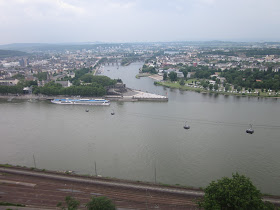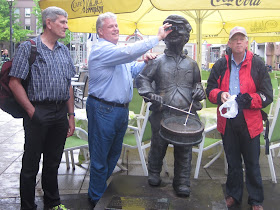Koblenz is located at the confluence of the Rhine and the Moselle Rivers. Established in 8 B.C., it has been a city of great military importance because of its location. I come from a town in California that is about 150 years old. It's hard to fathom that Koblenz celebrated its 2,000th birthday in 1992.
On the other hand, Koblenz was, like so many German cities, heavily bombed during World War II and has since been largely rebuilt. Perhaps overall the buildings in my city's "Old Town" are actually older than the buildings in Koblenz.
One of the city's newest structures is the 850m-long (2,788 ft.) Koblenz Cable Car system, built in 2010. It is the longest cable car outside of the Alps and the first of its kind in Germany.
Eighteen gondolas carry thirty-five passengers each from the city, across the Rhine, and up the mountain to the Ehrenbreitstein Fortress, which was constructed between 1817 and 1828. There was plenty of room for all of us. In fact, I think the ten of us were the only people in the car.
As a side note, there was an interesting exhibit on photoshopping in the fortress museum that used this famous statue as an example to show how pictures can be easily altered:
The current Ehrenbreitstein Fortress at the top of the gondola was completed by the Prussians in 1832 and has the unusual distinction of having never been attacked, even during World War II, when it was used to safeguard important papers and artifacts.
I also enjoyed the stained glass windows depicting various New Testament scenes, like this one of The Good Samaritan:
The floors in European churches are always so amazing. This geometric pattern was a cross of my niece Lisa's artwork and a very intricate quilting pattern:
A stroll around town took us to Goerresplatz, named after the Koblenzian poet Josef Goerres (1776-1848) and graced with a fantastic statue that depicts the entire history of Koblenz.
The Romans are on the bottom of the fountain, and successive tiers include conquering periods of Louis XIV and Napoleon, the destruction of World War II, and the rebuilding of the city into its current state (at the very top).
Such a monumental experience called for a bit of refreshment:
This has come to be one of my favorite gelato flavors--Milchspeiseeis nach Mozartkuegelart--milk chocolate with fudge and pistachio.
Doris, where is your gelato?!! Were you deterred because we had already eaten a Magnum Bar earlier in the day up at the Fortress? That's no reason not to partake! See Chris and Stan in the Gelateria?
I'm so glad they give instructions.
Our last stop in Koblenz was the Leibfrauenkirche, or "Church of our Beloved Lady"
On our way back to the boat, Bob tried to share some of his vegan delicacies with a stranger, but this young drummer turned up his nose at the offering:
Stan, however, gave him a look through his binoculars, and the boy seemed to enjoy that.
On the other hand, Koblenz was, like so many German cities, heavily bombed during World War II and has since been largely rebuilt. Perhaps overall the buildings in my city's "Old Town" are actually older than the buildings in Koblenz.
 |
| Bombing of Koblenz, 19 September 1944. Picture from here. |
Eighteen gondolas carry thirty-five passengers each from the city, across the Rhine, and up the mountain to the Ehrenbreitstein Fortress, which was constructed between 1817 and 1828. There was plenty of room for all of us. In fact, I think the ten of us were the only people in the car.
The gondola ride gave us a great view of the famous "German Corner" (Deutches Eck), the point of confluence of the Rhine and Moselle Rivers, with its famous statue of German Emperor William I. When the statue was installed in 1897, it bore the inscription "Never will the Empire be destroyed, so long as you are united and loyal." Ironically, the statue was damaged by bombing during World War II, and of course Germany was not united following World War II. The statue was actually removed by the West German Chancellor in 1949 and replaced with the coats of arms of all the former German States as a symbol of the West Germans' desire for a united Germany. German reunification occurred in 1990, and the statue was replicated and reinstalled in 1993, although many consider that to have been a move to encourage tourism.
As a side note, there was an interesting exhibit on photoshopping in the fortress museum that used this famous statue as an example to show how pictures can be easily altered:
The current Ehrenbreitstein Fortress at the top of the gondola was completed by the Prussians in 1832 and has the unusual distinction of having never been attacked, even during World War II, when it was used to safeguard important papers and artifacts.
Back in the city of Koblenz at the other end of the gondola ride we visited St. Kastor Basilica, built in 836 to honor the missionary St. Kastor, and largely rebuilt around 1200. Because of its strategic location at the confluence of the Rhine and Moselle, many important political meetings have taken place here. It was damaged during the war, although it remained largely intact. A 25-year renovation project began in 1948.
I loved the beautiful tapestry placed behind the baptismal font signifying "baptism by fire," or the Holy Spirit. Do you see the dove reaching down into the flame and smoke? I haven't been able to find out any information about it, such as how old it is, but it looks very modern.
 |
| Detail of tapestry |
The floors in European churches are always so amazing. This geometric pattern was a cross of my niece Lisa's artwork and a very intricate quilting pattern:
A sign next to the statue explained its symbolism (in German and English, thank goodness):
The artist . . . doesn't let history climb in a rising spiral (as for instance the famous Trajan's Column in Rome), but arranges it by episodes, one on top of the other, sometimes divided by layers of destruction. History for him is not progressive, "improving" development, but is always a new beginning which emanates mostly from the demolished past on which it is based, but is essentially something different.
Such a monumental experience called for a bit of refreshment:
This has come to be one of my favorite gelato flavors--Milchspeiseeis nach Mozartkuegelart--milk chocolate with fudge and pistachio.
Doris, where is your gelato?!! Were you deterred because we had already eaten a Magnum Bar earlier in the day up at the Fortress? That's no reason not to partake! See Chris and Stan in the Gelateria?
I'm so glad they give instructions.
Our last stop in Koblenz was the Leibfrauenkirche, or "Church of our Beloved Lady"
On our way back to the boat, Bob tried to share some of his vegan delicacies with a stranger, but this young drummer turned up his nose at the offering:
Stan, however, gave him a look through his binoculars, and the boy seemed to enjoy that.
I'm pretty sure I heard my mom giggling as she watched us.
Beautiful Koblenz: A wonderful city for a stroll.























































